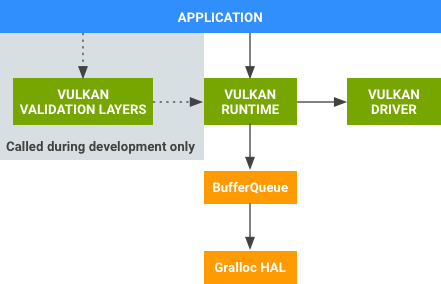Android supports Vulkan, a low-overhead, cross-platform API for high-performance 3D graphics. Like OpenGL ES (GLES), Vulkan provides tools for creating high-quality, real-time graphics in apps. Advantages of using Vulkan include reduced CPU overhead and support for the SPIR-V Binary Intermediate Language.
System-on-chip (SoC) vendors, such as GPU independent hardware vendors (IHVs), write Vulkan drivers for Android. OEMs integrate these drivers for specific devices. For details on how a Vulkan driver interacts with the system, how GPU-specific tools are installed, and Android-specific requirements, see Implementing Vulkan.
Application developers use Vulkan to create apps that execute commands on the GPU with significantly reduced overhead. Vulkan also provides a more direct mapping to the capabilities found in current graphics hardware compared to EGL and GLES, minimizing opportunities for driver bugs and reducing developer testing time.
For general information on Vulkan, see the Vulkan Overview or see the list of Resources.
Vulkan components
Vulkan support includes the following components.

Figure 1. Vulkan components
| Component name | Provider | Description |
|---|---|---|
| Vulkan Validation Layers | Android (in the NDK) | Libraries used during the development of Vulkan apps to find errors in an app's use of the Vulkan API. After API usage errors are found, these libraries are removed. |
| Vulkan Runtime | Android | A native library, libvulkan.so, that provides a native
Vulkan API.Most of Vulkan Runtime's functionality is implemented by a driver provided by the GPU vendor. Vulkan Runtime wraps the driver, provides API interception capabilities (for debugging and other developer tools), and manages the interaction between the driver and the platform dependencies. |
| Vulkan Driver | SoC | Maps the Vulkan API onto hardware-specific GPU commands and interactions with the kernel graphics driver. |
Modified components
BufferQueue and Gralloc support Vulkan:
- BufferQueue. Additional enum values and methods in
BufferQueue and the
ANativeWindowinterface enable Vulkan Runtime to connect to BufferQueue throughANativeWindow. - Gralloc. An optional interface lets Gralloc discover whether a given format can be used for a particular producer/consumer combination without allocating a buffer.
For details on these components, see
BufferQueue and
gralloc. For details on ANativeWindow, see
EGLSurfaces and OpenGL
ES.
Resources
Use the following resources to learn more about Vulkan:
-
Vulkan Loader (
libvulkan.so) atplatform/frameworks/native/vulkan. Contains Android's Vulkan loader, as well as some Vulkan-related tools useful to platform developers. - Implementing Vulkan. Intended for GPU IHVs writing Vulkan drivers for Android and OEMs integrating those drivers for specific devices. It describes how a Vulkan driver interacts with the system, how GPU-specific tools should be installed, and Android-specific implementation requirements.
- Vulkan Graphics API Guide. Includes information on getting started with using Vulkan in Android apps, Android's Vulkan design guidelines platform, using Vulkan's shader compilers, and using validation layers to help ensure stability in apps using Vulkan.
- Vulkan News. Covers events, patches, tutorials, and more Vulkan-related news articles.
